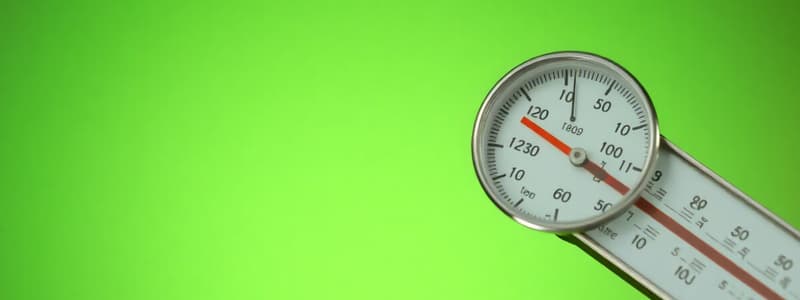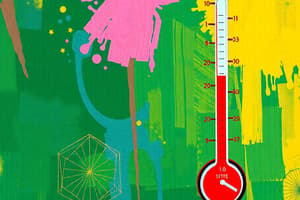Podcast
Questions and Answers
Which scale uses the unit increments that are equivalent to the Fahrenheit scale?
Which scale uses the unit increments that are equivalent to the Fahrenheit scale?
- Kelvin
- Rankine (correct)
- Celsius
- Reaumur
What is the relationship between degrees Celsius and degrees Fahrenheit based on the conversion formula?
What is the relationship between degrees Celsius and degrees Fahrenheit based on the conversion formula?
- 1 °C = 1.8 °F
- 1 °F = 1.8 °C
- 1 °C = 32 °F
- 1.8 °C = °F - 32 (correct)
What type of system is a filled thermal system considered to be?
What type of system is a filled thermal system considered to be?
- Closed system (correct)
- Dynamic system
- Static system
- Open system
Which temperature scale is preferred in the United States?
Which temperature scale is preferred in the United States?
How does one convert Kelvin to Celsius?
How does one convert Kelvin to Celsius?
What is the key characteristic of a filled thermal system in relation to temperature measurement?
What is the key characteristic of a filled thermal system in relation to temperature measurement?
Which statement about the Celsius scale is true?
Which statement about the Celsius scale is true?
What does the Rankine scale have in common with the Kelvin scale?
What does the Rankine scale have in common with the Kelvin scale?
What is the conversion factor for changing Kelvin to Rankine?
What is the conversion factor for changing Kelvin to Rankine?
What occurs during the heat transfer method known as conduction?
What occurs during the heat transfer method known as conduction?
What is the definition of temperature as discussed in the content?
What is the definition of temperature as discussed in the content?
Which statement accurately describes the process of boiling in terms of temperature and heat energy?
Which statement accurately describes the process of boiling in terms of temperature and heat energy?
Which unit defines the amount of heat required to raise the temperature of 1 gram of water by 1 degree Celsius?
Which unit defines the amount of heat required to raise the temperature of 1 gram of water by 1 degree Celsius?
In the context of heat transfer, what method relies on the motion of fluids due to density differences?
In the context of heat transfer, what method relies on the motion of fluids due to density differences?
When a substance transitions from solid to liquid, what is true regarding the heat energy added?
When a substance transitions from solid to liquid, what is true regarding the heat energy added?
What describes superheated steam?
What describes superheated steam?
Which of the following statements about heat flow is accurate?
Which of the following statements about heat flow is accurate?
Which statement correctly describes radiation as a heat transfer method?
Which statement correctly describes radiation as a heat transfer method?
What phenomenon stabilizes temperature at the melting and boiling points of water?
What phenomenon stabilizes temperature at the melting and boiling points of water?
Which device uses the principle of two dissimilar metals expanding and contracting at different rates?
Which device uses the principle of two dissimilar metals expanding and contracting at different rates?
Which temperature measurement scale uses 0 degrees as the freezing point of water?
Which temperature measurement scale uses 0 degrees as the freezing point of water?
What is the primary reason distilled water is used as a calibration standard?
What is the primary reason distilled water is used as a calibration standard?
Which of the following statements about thermocouples is incorrect?
Which of the following statements about thermocouples is incorrect?
What is the key feature of a thermowell?
What is the key feature of a thermowell?
What impact does decreasing pressure have on the boiling point of water?
What impact does decreasing pressure have on the boiling point of water?
How does a resistance temperature device (RTD) measure temperature?
How does a resistance temperature device (RTD) measure temperature?
What characteristic is true of a thermistor compared to other temperature sensors?
What characteristic is true of a thermistor compared to other temperature sensors?
What is the primary application of infrared thermometers (pyrometers)?
What is the primary application of infrared thermometers (pyrometers)?
Flashcards are hidden until you start studying
Study Notes
Temperature and Heat
- Temperature is the average kinetic energy of a material.
- Heat is the amount of energy that flows over time between differing temperatures, always from high to low.
- British thermal unit (BTU) is the amount of heat required to raise the temperature of a pound of water by 1 degree Fahrenheit.
- 1 calorie is the amount of heat required to raise the temperature of 1 gram of water by 1 degree Celsius.
- Heat can be transferred by conduction, convection, and radiation.
Temperature Measurement
- Temperature is measured at a given point in time using specific tools.
- Temperature measurement can be done at single points, multiple points, multiple averaging points, or as differentials.
- Temperature scales include Fahrenheit, Celsius, Kelvin, and Rankine.
- Water is used as a reference point for boiling and freezing because pure water can be produced globally.
Temperature Sensing Instruments
- Thermometer: A self-contained device that determines a substance's temperature.
- Glass stem thermometer: Constructed with a bulb, capillary tube, and a numbered scale that changes with temperature.
- Infrared thermometer (pyrometer): Measures surface temperature by detecting light waves.
- Bimetallic strip: Composed of two dissimilar metals bonded together.
- When heated, the strip bends because the metals expand at different rates.
- Used in temperature switches, thermal motor overloads, and other applications.
- Resistance temperature device (RTD): Measures temperature changes based on electrical resistance.
- More linear and accurate than thermocouples but have a limited operating range.
- Metals commonly used include platinum, nickel, iron, and copper.
- Thermocouple: The most common and simplest electrical temperature sensing element in the industry.
- Consists of two dissimilar metals joined at one end that generate a small voltage when heated.
- This voltage is linear to the temperature difference and provides a good sensing element.
- Color-coded wires help with identification.
- Cold junction compensation is necessary to correct for false readings caused by connecting wires.
- Thermistor: A small ceramic resistor with a high temperature coefficient of resistance.
- Sensitive to small temperature changes and responds quickly.
- Often made as a bead encased in glass.
- Prone to long-term drift due to aging.
- Thermowell: A protective device that isolates temperature sensors from harsh conditions.
- Allows for easy sensor removal without shutting down equipment.
- Made of corrosion-resistant material and comes in direct contact with the process.
- Temperature Gauge: An independent analog device that indicates temperature changes on a calibrated face.
- Uses a sensing element like a bimetallic strip, bourdon tube, or bellows.
- Allows for viewing from a distance.
- Filled thermal system: A closed system that uses a bulb filled with a liquid, vapor, or gas connected to a pressure measuring element.
- Changes in process temperature affect the pressure and volume of the fluid/gas within the bulb, influencing the gauge's reading.
Temperature Conversions
- Celsius is preferred internationally, while Fahrenheit is preferred in the US.
- The Celsius unit is 1.8 times larger than the Fahrenheit unit.
- Kelvin is an absolutes scale that uses the Celsius degree unit.
- Rankine is the Fahrenheit equivalent of the Kelvin scale, with absolute zero at 0°R.
Studying That Suits You
Use AI to generate personalized quizzes and flashcards to suit your learning preferences.




